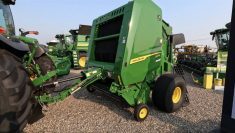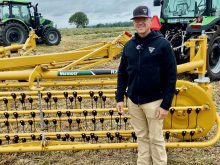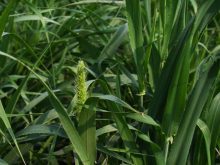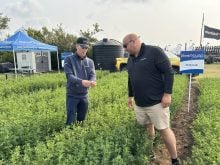When shopping for the right alfalfa variety, it’s usually well worth splurging for a top yielder, retired University of Wisconsin-Madison professor and forage expert Dan Undersander says.
Undersander ran 298 alfalfa yield trials between 1985 and 2016, results of which clearly showed penny-pinching doesn’t pay off when it comes to choosing a variety.
“Out of those 298 trials on average, the top variety yielded one-and-a-third tons more than the lowest variety in the seeding year,” he says. “You would have got your seed cost back in the seeding year.”
Read Also

Fertilizer method’s link to emissions studied
A researcher says others studying greenhouse gas emissions aren’t considering how the loss of nitrogen into the atmosphere correlates with fertilizer application or if there is an impact to yield.
Undersander led the Canadian Forage and Grassland Association’s intensive three-day forage workshop at the University of Manitoba on March 5-7, where he discussed the main considerations for a grower deciding on an alfalfa variety. Yield topped his list of these considerations for the simple reason that profitability increases with yield.
The reason for this, he says, is that many of the costs remain the same whether a high-yielding or low-yielding variety is chosen. Taxes, land expenses and harvest costs, for examples, are generally consistent. He pointed out there’s only about a five per cent difference in cost between producing one ton of yield versus two tons. Higher yield also enables farmers to produce more forage with fewer acres.
“That’s something that people should be thinking about, particularly as land taxes go up,” Undersander says, but adds that yield data is often difficult to come by, since most provinces and states have eliminated forage yield testing.
“Another one of the benefits you get from a premium variety is good disease resistance,” Undersander says. “The good varieties have it; the cheaper ones don’t. So look for that.”
When selecting varieties, he says it’s important to understand how disease resistance is measured. In alfalfa breeding, varieties are evaluated based on the percentage of plants that are resistant to specific diseases. If at least 50 per cent of the plants in a variety are resistant, the variety is classified as highly resistant to that disease.
It’s important to recognize, though, that this still means nearly half of the plants may be susceptible, which can lead to disease problems in the field.
Undersander recommends farmers make an effort to figure out which diseases are present on their farms.
“Go out and walk through fields and see what you think you’ll need resistance to,” he says. “You don’t need resistance to every variety, every location. You also don’t need it every year.”
Winter hardiness
Undersander explains that winter hardiness is highly dependent on location — and more of a concern, then, in colder regions such as the Canadian Prairies.
One of the biggest factors in determining winter survival is the amount of snow cover. If there’s good snow cover, many varieties can survive the winter. However, without snow cover, farmers need to pay closer attention to other factors that influence winter hardiness.
“We’ve had California types survive for us in central Wisconsin, where we had good snow cover,” Undersander says.
Soil fertility is another critical factor — particularly the potassium levels, which should be kept high going into the winter to help alfalfa plants survive the cold months. Additionally, the frequency of cutting can affect winter survival.
“Some of the beef cattle producers who cut less frequently have better winter survival than dairy producers because they’re building more root carbohydrates with each cutting,” he says.
Lastly, whether you take a late fall cutting can influence survival. Undersander generally recommends taking a late cutting if snow is expected, as it helps the plants enter winter with a better chance of survival.
Fall dormancy
Closely tied to winter survival is fall dormancy, which refers to how much an alfalfa plant continues growing after a fall cutting.
Undersander points out there has been a trend to lean on less dormant varieties because they yield more. They start growth earlier in the spring and recover faster after cutting.
Alfalfa fall dormancy is measured on a scale from 1 to 10, with lower numbers indicating more dormant varieties that shut down earlier in the fall. In colder regions like the Prairies, dormancy ratings of 2 or 3 are typical, while much of the U.S. grows dormancy 4 varieties. Warmer regions, such as Florida or southern California, rely on dormancy 8 or 9.
However, Undersander notes, choosing a variety with too little dormancy for your region can lead to problems.
“A few companies have tried introducing dormancy 5s or 6s in Wisconsin,” he says. “But then you get some 70 F (21 C) days in January, and the buds start to grow. And you know it’s not going to stay 70 F.”
When the cold returns, that premature growth can be damaged, reducing stand longevity. In contrast, 3s or 4s take longer to break dormancy, making them less likely to be triggered by a short warm spell.
“You might have two or three warm days, but you won’t likely have a week that’s enough to trigger a dormancy 3 or 4,” Undersander explains.
Stand persistence
At the workshop Undersander also briefly touched on the concept of stand persistence in alfalfa. In general, persistence refers to the ability of an alfalfa variety to remain productive over multiple growing seasons.
For farmers looking to grow alfalfa for several years before replanting, persistence is important because it ensures a variety can withstand multiple seasons of harvesting and continue to contribute to soil health and forage production.
However, Undersander also notes the benefits of short rotations. He points out that older stands tend to yield less, and weed problems tend become more pronounced.
In such rotations, the key advantage of alfalfa is its ability to fix nitrogen, meaning persistence is a less important trait. And it would largely be determined by disease resistance, winter hardiness and fall dormancy.
“Our mistake with alfalfa is thinking of it only as a forage,” Undersander says. “While that’s a worthwhile thing, alfalfa not only produces enough nitrogen for itself and any grasses you put with it, but it also produces enough for the crop the next year when you plow it down.”


















